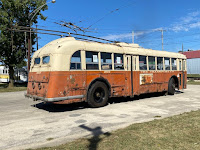And they have also restored some local freight equipment, as seen here.
Hicks Car Works
News and views of progress at the Illinois Railway Museum
Sunday, October 20, 2024
Back from Arizona
Posted by
Randall Hicks
at
4:00 PM
0
comments
![]()
Labels: Trip Reports
Sunday, October 13, 2024
Painting and Pouring
Frank writes...
That was the least of the painting news, though. Over in Yard 2, Jamie spent the entire day Friday spraying a coat of primer onto one of the bi-level cars we acquired back in January, helped by other Diesel Department volunteers. Saturday, he started with the green - this car will be painted as C&NW 83 and will match our existing three-car set of C&NW bi-levels.
Posted by
Frank Hicks
at
8:00 PM
1 comments
![]()
Labels: Building and Grounds
Wednesday, October 9, 2024
In Memoriam - Jerry Kosinski
Posted by
Frank Hicks
at
10:06 PM
0
comments
![]()
Monday, October 7, 2024
Steaming Into Fall
Frank writes...
As part of the Steam Into Fall festivities, Jeff had the cab of the UP rotary snow plow open for visitors.
Jeff is on the left, with a couple of visitors at top and right. Jeff said the cab tour was very popular all weekend and he hopes to bring it back for at least one or two events next year. Stay tuned!
Back in the Car Department, work was progressing on the end of North Shore 250, which is in the process of being restored as a display piece. Our friend Steve was visiting from Oklahoma; he and Mike were working on the Kansas City PCC, piecing in new steel at the bottom of the center post for the rear doors, where there was a lot of rust. Zach, Richard and Steven were working on bus-related things. Most of the crew - Nick, Greg, Joel, Jimmy, Ashton, Dan, and maybe others - were working on clearing spare parts from the area behind the shop. The hope is that the piles of rock will be appropriately distributed, and the volunteer lot paved, before the snow flies.
Finally, after dark, we got to see the 1630 returning from its final trips of the year. Here, it's stopped alongside the diner while the crew chats with Greg and Joel before pulling into the steam servicing area.
Posted by
Frank Hicks
at
6:31 PM
0
comments
![]()
Labels: Shaker Heights 63
Saturday, October 5, 2024
Shuffling the Deck
Bill Wulfert sends us pictures of a recent switch move in Barn 4. The 1808 was moved from track 43 to 42, and the 1268 is now on the west end with 1808 behind it on the east.
Posted by
Randall Hicks
at
6:48 PM
1 comments
![]()
Wednesday, October 2, 2024
277 Progress Report
 |
| A few weeks ago, the center door was reinstalled. The seat bases were also cleaned up and painted silver like all the other hardware in the car. |
 |
| The area where the two seats were. The four window sash are being restored also. |
Posted by
Randall Hicks
at
9:08 PM
2
comments
![]()
Labels: 277 Progress
Tuesday, October 1, 2024
Sunday Night on WGN
Our good friend Art Peterson has sent us some good news: he will be appearing on WGN's program "Backstory" this Sunday, October 6th, at 11pm. The subject of the episode will be nostalgia, of course a subject near to our hearts, and they'll be featuring Art and his collection. The episode will also be available on WGN's website starting the following day. Don't miss it!
Posted by
Frank Hicks
at
9:57 PM
0
comments
![]()
Thursday, September 26, 2024
You're Invited
...to the 13th Annual Steam Department Benefit! This is a unique and unforgettable event at a stunning venue, plus the proceeds go to help steam restoration and maintenance at IRM, of course. Click here for more info and to purchase tickets.
Posted by
Frank Hicks
at
11:00 PM
0
comments
![]()
Wednesday, September 25, 2024
We Come Bearing News
It took about a year, but the brass foundry has just completed the three sets of motor bearings we need to finish replacing the ones on the 309's #1 truck. They've already been delivered to the machine shop that will be doing the necessary machining, the same place that did the first one. The first one was installed earlier this year and tested; it runs fine, not measurably hotter than the old ones.
Posted by
Randall Hicks
at
5:00 PM
0
comments
![]()
Tuesday, September 24, 2024
Vermilion and Ivory
Frank writes...
In other news, the center and west portions of the car shop were cleaned out for Arnfest, which is happening next weekend. This resulted in the palletized items shown here being moved out into the new Barn 4 extension. Thanks to Nick and Greg for working with me to move some spare parts around. Hey, anyone have 2x4's they don't need? We could use them to build heavy-duty shelves. Inquire within!
And Bus Day was over, but Richard and Joel showed me the above "punch card," which I thought was a nifty idea. I guess they've been doing this for a couple of years, but I am rarely out on Saturdays so I hadn't encountered it before.
Posted by
Frank Hicks
at
12:00 PM
2
comments
![]()
Labels: Shaker Heights 63
Monday, September 23, 2024
Bill Wulfert's Bus Day Bash
Luckily, I have friends who can usually provide pictures of anything I missed -- in this case, Bus Day!
So thanks, Bill!
Posted by
Randall Hicks
at
4:51 PM
5
comments
![]()
Labels: Bill Wulfert Photos
















































